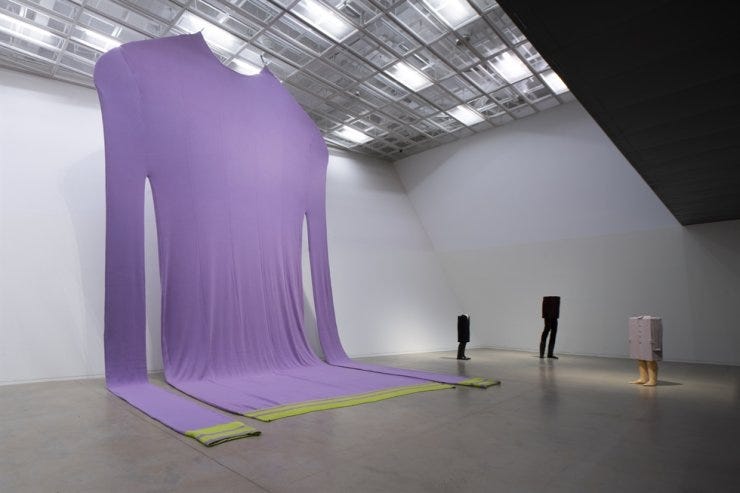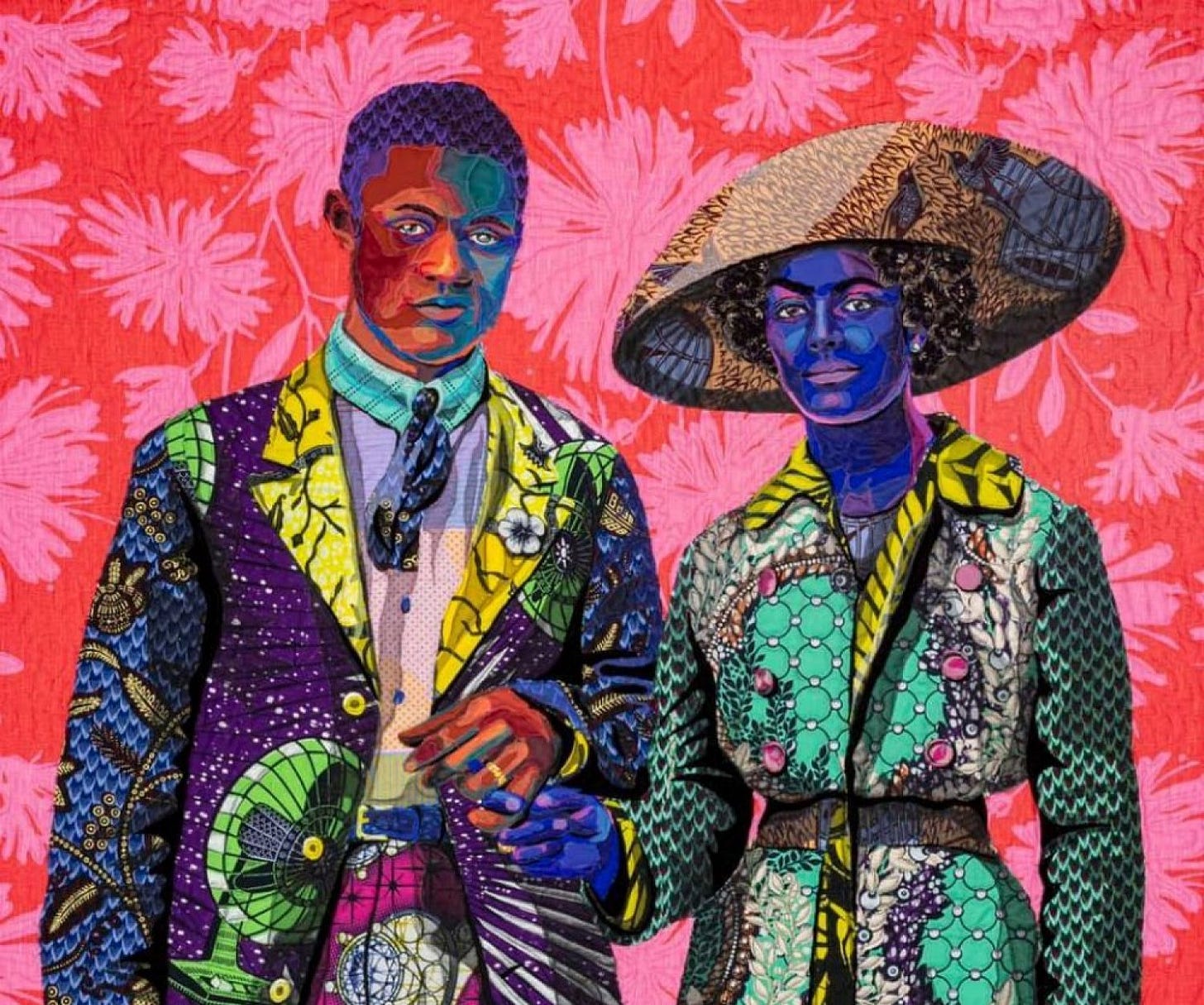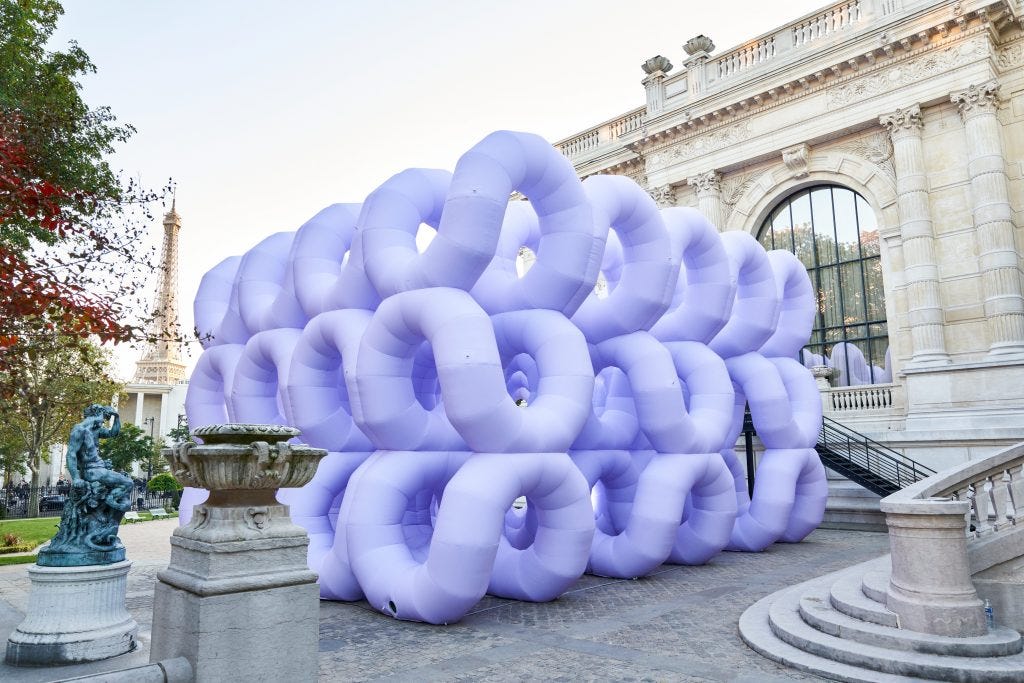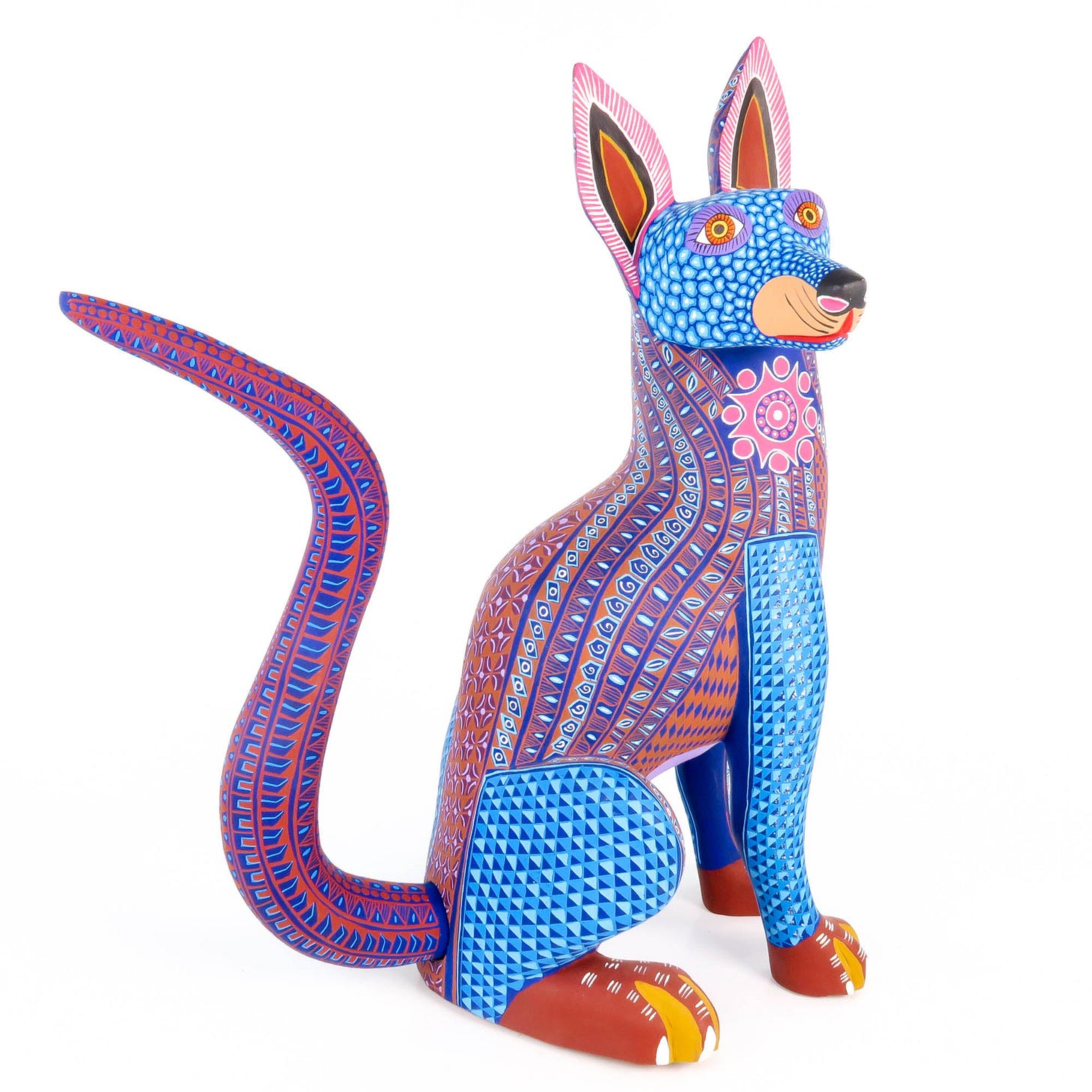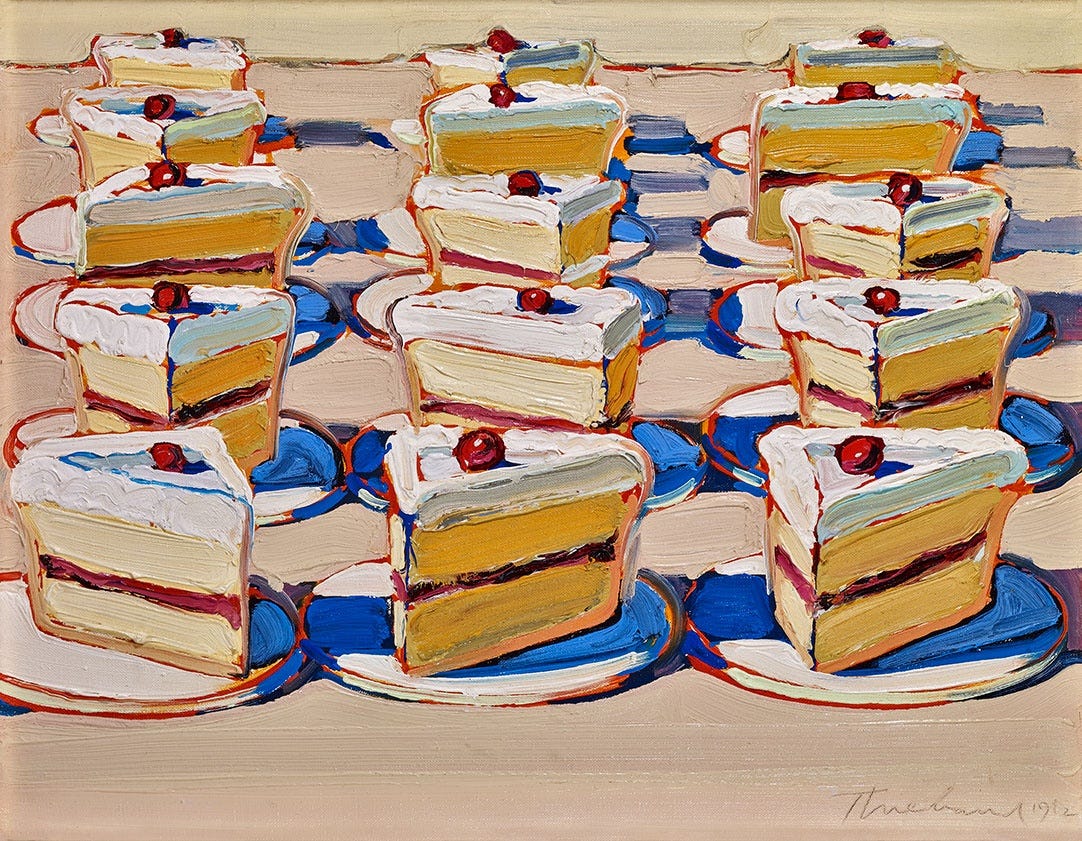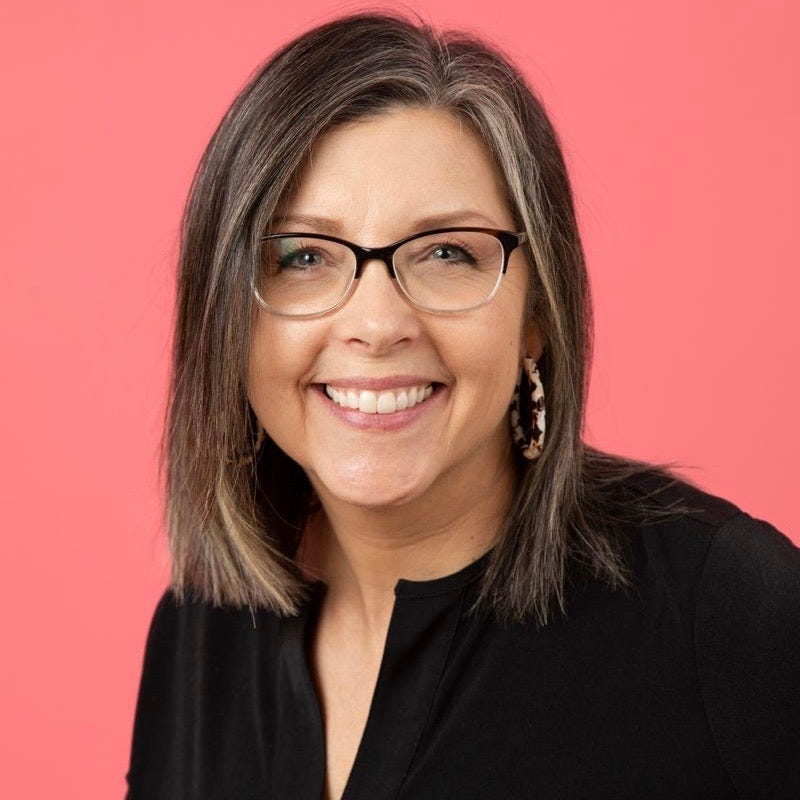Purple
Dessert Tray, Wayne Thiebaud
Dessert Tray, 1992-1994 by Wayne Thiebaud Image: Courtesy of waynethiebaudart on Instagram
California artist Wayne Thiebaud is perhaps best known for his paintings of cakes, pies, and candies from the 1950s and '60s: still-lifes for the consumer age. I couldn’t resist featuring the master of color, Thiebaud, this week as many of his paintings incorporate purple and purple-blue shadows which keeps them lively and interesting, in my view.
See
One Minute Forever, Erwin Wurm
The exhibition, "Erwin Wurm: Sculpture is Everywhere," at the Suwon Museum of Art in Suwon, Gyeonggi Province, is the Austrian sculptor's largest solo exhibition ever held in Korea. Courtesy of Suwon Museum of Art. The sweater, weighing a total of 300 kilos (661 lbs) is designed to convey the message of a “warming and protective second skin.” (Brown Pelican)
Broom Jumpers, Bisa Butler
This artwork, titled "Broom Jumpers (Detail)" by Bisa Butler, is made of cotton, silk, wool, and velvet. It measures 98 inches by 58 inches. Bisa Butler creates vibrant, life-size quilt portraits of Black Americans. The unique process by which she translates photographs into luminous, pieced-cloth images is a synthesis of her formal artistic studies and family traditions. Butler's work includes several AfriCOBRA principles: positive images of Black people, a play between representation and abstraction, and the use of what the collective referred to as “Kool-Aid” colors, including bright orange, strawberry, cherry, lemon, lime, and grape. (Sixty Inches from Center)
Remember Your Dreams, Cyril Lancelin
Lancelin explores the blurred lines between the real and the unreal. Much of his work involves giant, bright, boundary-pushing sculptures placed in ordinary settings—creating otherworldly experiences for people going about everyday life.
This installation, commissioned by the German automaker Porsche, is made of inflatable and very purple polyester tubes, Remember Your Dreams sits alongside the Palais Galliera, also known as the Musée de la Mode de la Ville de Paris (until October 24, 2021). (Artnet)
Vigilant Dog - Oaxacan Alebrije Wood Carving, Ramirez Family
Beautiful dog alebrije wood carving by the Ramirez family. Handcrafted out of copal wood at their workshop in Oaxaca, Mexico. The carving was done using traditional techniques passed down over several generations and was done only using simple tools such as machetes, knives, and chisels. The detailed painting incorporates designs inspired by the ancient Zapotec which has a great presence in Oaxacan culture.
Say
Physical Effects- Purple calms and stimulates our bodies, putting us in the right place for introspection and focused insight. It fosters creativity by awakening our senses while promoting the quiet necessary to make intuitive, insightful observations. Purple creates a harmonious balance of awareness and peace. (Sensational Color)
There is a sweetness to purple. It feels like these pieces embody a kind of innocence. How does looking at these artworks make you feel?
Do you like the color purple? If so, which purple? If not, articulate why.
Which of these artworks feels most powerful to you? Why?
Do
“I love it when people smile at my work, it’s for pleasure really” -Wayne Thiebaud
Do something to make someone smile today!
Read 5 Wayne Thiebaud Paintings Capturing His Vibrant Vision of American Culture
Watch a brief interview with Thiebaud:
About the Artist: Wayne Thiebaud
Morton Wayne Thiebaud ( TEE-boh; November 15, 1920 – December 25, 2021) was an American painter known for his colorful works depicting commonplace objects—pies, lipsticks, paint cans, ice cream cones, pastries, and hot dogs—as well as for his landscapes and figure paintings. Thiebaud is associated with the pop art movement because of his interest in objects of mass culture, although his early works, executed during the fifties and sixties, slightly predate the works of the classic pop artists. Thiebaud used heavy pigment and exaggerated colors to depict his subjects, and the well-defined shadows characteristic of advertisements are almost always included in his work. (Tate)
When Thiebaud paints an object or form, he famously surrounds it with multiple colors, often stripes or lines, of equal intensity, to create a halo effect—though you might not notice that unless you look closely. “They’re fighting for position,” he says of the colors. “That’s what makes them vibrate when you put them next to each other.” (Smithsonian)
Please share your reflections with me by replying to this post and tagging my Wonder Wander Facebook or Instagram pages!





